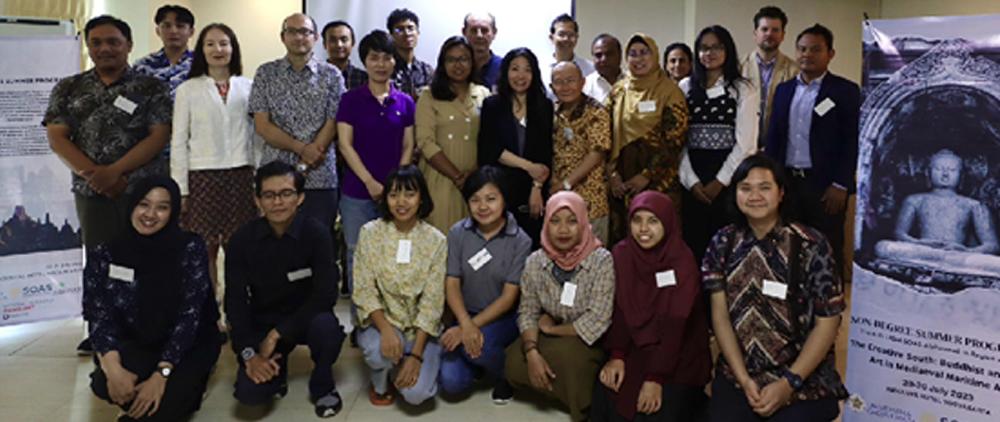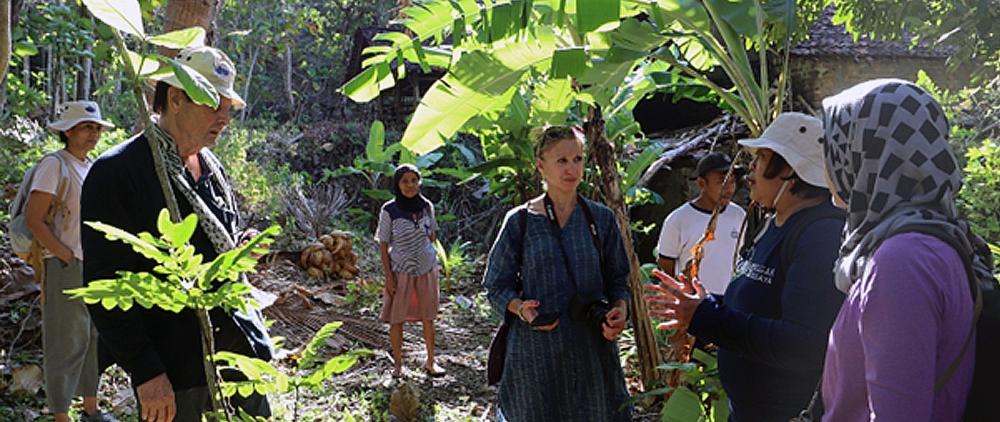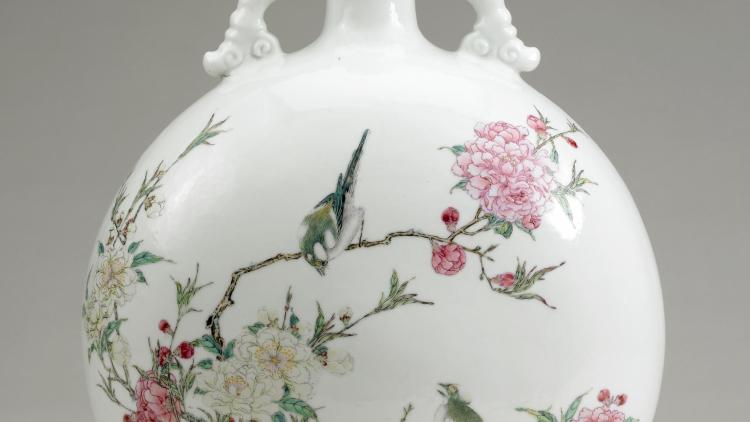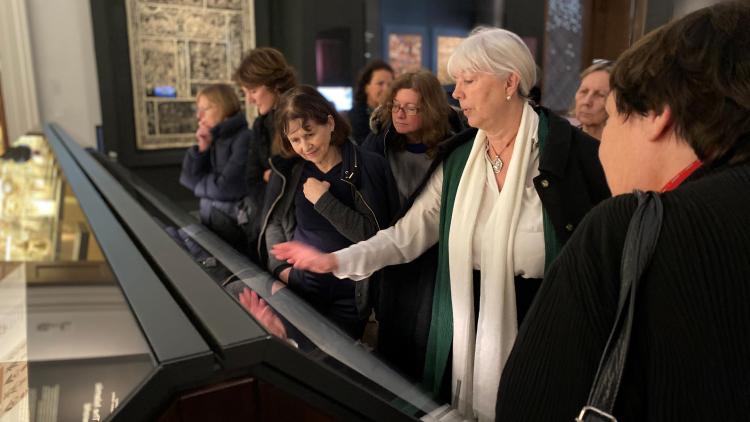2023 SAAAP Summer Programme at UGM Yogyakarta
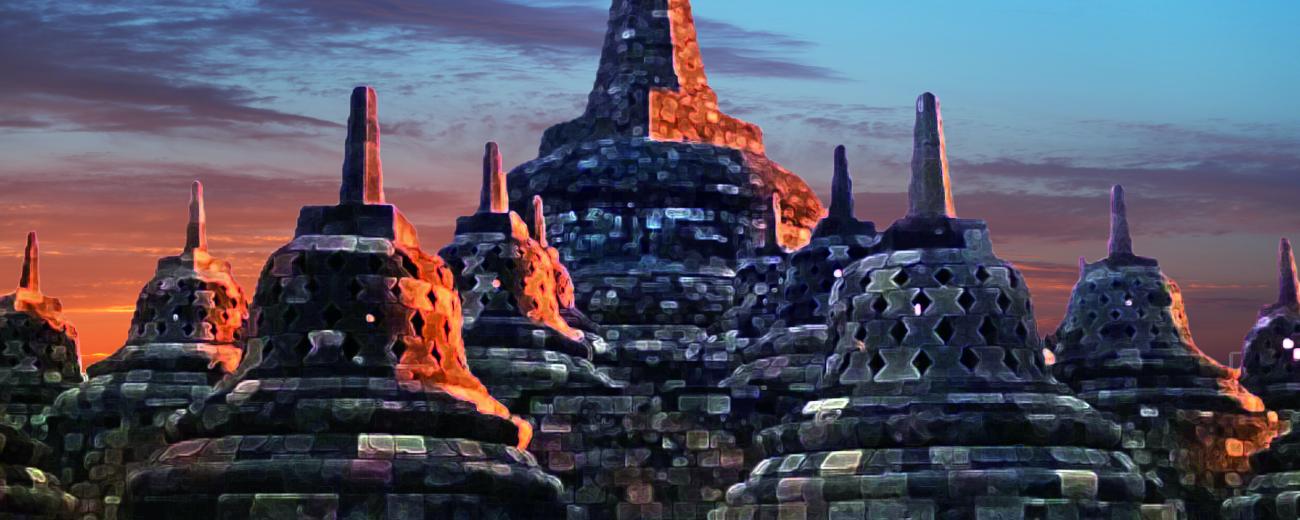

The 6th annual SAAAP Summer Programme, hosted by regional partner Universitas Gadjah Mada in Yogyakarta, drew in international and Indonesian scholars as well as Alphawood alumni to contribute to redefining the overlooked yet powerful innovative role of the growing maritime states along the southern edge of the Asian landmass in the early second millennium of the common era.
The innovations focused on this year were the evolution of cults with fierce Tantric Buddhist deities in interlinked communities across the region, as Buddhism faced extinction in India; the construction of Buddhist and Hindu state monumental centres on a unprecedented scale in the burgeoning Javanese and Khmer empires; the invention of state-sponsored free public health systems in 12th century Cambodia; the earliest evidence of the decimal system in use in 7th century Sumatra and Cambodia, and the evolution of an influential form of Theravada Buddhism in post-Bagan Myanmar and northeast Thailand.
Surocolo
East Java’s unique Tantric Buddhist bronze mandalas were a special focus this year because curator Emma Natalya Stein is seeking Indonesian government permission to fly the Surocolo bronzes from Yogyakarta to Washington for an exhibition at the National Museum of Asian Art, Smithsonian.
Alphawood alumnus Eko Bastiawan, now a PhD candidate at Indonesia’s Bandung University, launched the group deep into the study of the mandalas and what they reveal about Javanese society at the turn of the first millennium, with a detailed comparative study of the Surocolo bronzes and the probably contemporary Ponorogo bronzes found towards the eastern end of the island of Java.
The group drove south of Yogyakarta to the coast to visit the mountain findspot of the 17 bronzes found buried in a pot, below the Surocolo cave.
The cave was used as a refuge in the 18th century by a local Islamic ruler whenever a Dutch colonial inspection group reconnoitred the region. Why the small, perfectly cast sacred bronzes were buried here in a ceramic vessel, centuries earlier, remains a mystery. We await access to the original discovery report for any clue as to when and why they were interred on this isolated coastal mountain. The Indonesian archaeologists accompanying us said a survey earlier this year with a metal detector found nothing.
The two mandalas have a large number of deities in common but the exact mandala has yet to be determined. Iain Sinclair of Queensland University relayed his research on the 8th century Sarvabuddhasamāyoga (‘Equivalence of all Buddhas’) Tantra, extant only in Tibetan, with which humans can bring out their ‘inner deity’ through yoga, sacred song and dance, and achieve direct contact the Buddhist cosmos in this lifetime. This launched Buddhism’s 3rd ‘thunderbolt’ wave called the Vajrayāna. The 8th century Buddhist patriarch Amoghavajra, who passed through Srivijaya and Java on his way to becoming the first imperial mandarin in Tang China, wrote a summary of it.
Scholars date the Surocolo, Nganjuk and Ponorogo bronzes variously from the 9th-11th centuries and some link Surocolo to the 10th century Javanese Buddhist text Saṅ Hyaṅ Kamahāyānikan from the reign of King Sindok (927-47 CE). The supreme mandala deity is Vajrasattva, the primordial Ādibuddha of the Vajrayāna. The Vajrasattva in the Surocolo group looks iconographically later than the others and may be an ancient replacement for the original. Iain and Emma now have to determine the best fit mandala for displaying the incomplete set of bronzes in Washington.
Claudine Bautze-Picron asked what light the fierce Buddhist images of power and protection, now being studied across Maritime and East Asia, throw on the roles of the 11th-12th century images of Mahākāla, Heruka/Hevajra and tantric Avalokiteśvara found scattered, but without clear context, in or near the soon to be devastated Buddhist viharas of Bengal and the Ganges Valley.
These late Buddhist images have so far mostly been considered in relation to the iconography in literary sources and have not been anchored into their historical contexts. Faced with annihilation by Turkic armies late in the 12th century, the prime role of the fierce deities must have been the defence of the Buddhist sangha in Pala-Sena Bengal. Further, close comparisons of icons in south Bengal and Sumatra in Indonesia show a very close relationship between the Buddhist communities in these places, far apart but linked by the sea-lanes in the critical 11th and 12th centuries. Claudine concluded that in the rapid spread of ‘state protection Buddhism’ outside the subcontinent, Mahākāla protected large areas in China and Indonesia and Hevajra held sway in Cambodia and Campa. In the 13th century, Mahākāla and Hevajra protected Yuan China at Dadu, as well as Java and Sumatra, while a tantric Avalokiteśvara also protected Cambodia, Campā, Java-Sumatra and Dali in Yunnan. In East Java this central position was shared with Śiva.
World first free state hospital system in Cambodia
This year there were lectures from Cambodian Alphawood alumni Yav Huon and Pheoung Dara, who have key roles in restoring the ancient Khmer hospital sites. They showed what is being discovered about operations of the four hospitals constructed outside Angkor’s 12th century fortified capital Angkor Thom. They will later be prepared for a specialised tourist circuit.
Yav is known for intuiting the exact spot beside the northern hospital, where a stone Bodhisattva Sunlight or Moonlight, the companions of the Khmer medical Buddha Bhaiṣajyaguru, lay close under the surface. Later he excavated a large stone dvārapāla guardian statue, which may have protected King Jayavarman’s store of precious medical substances, which included gold and mercury.
Peter Sharrock showed the scale of the king’s investment in the chain of hospitals, each with 100 staff, that stretched across present Cambodia, Thailand and Laos. The special role of Banteay Chhmar temple, set below the Dangrek Mountains where the medicinal herbs were collected, was the centre for extended rituals for making the herbs potent with the light of the medical Buddha Bhaiṣajyaguru. Inscriptions indicate 3-monthly deliveries to each hospital of precise quantities of honey, wax, sesame, butter, pepper, cumin, muscade, nutmeg, camphor, sugar, cardamom, ginger, oregano, mustard, sandalwood and rice. Francesco Franchini said late 13th century Yuan Dynasty envoy Zhou Daguan mentions herbal medicine stalls in Khmer markets and differences from Chinese medicine including snake-bite cures.
Khmer zero
Iwan Pranoto, from the Bandung Institute of Technology, said the idea of zero as a number and the 10-based place value system, or decimal system, as commonly used today, was a fundamental creation of human civilization as it is impossible to imagine science and technology advancing if we still used non-place-value systems, such as the Roman numbering system. Zero was possibly first conceived as a number at the great Buddhist monastery of Nalanda's by its greatest mathematician Aryadhata. For the Buddhists zero or sunya (emptiness) was important as it is the state, induced by study and meditation, that is a prerequisite for purifying oneself for reaching nirvāṇa. Indian sources on the invention of the decimal system are thin and the first hard evidence is a 7th century temple inscription in Cambodia giving the date 603 CE, and 604 CE in Sumatra. Iwan concludes that Monsoon Asia grew wealthy fast by rapidly absorbing new instruments for intellectual, cultural and commercial growth.
Campā and Java
Tantric goddesses are beginning to emerge as a major component of the Buddhism of strongly matriarchical territory of Campā, in modern central Vietnam. Scholars Tran Ky Phuong and alumna
Nguyen Thi Tu Anh write on this in the SAAAP joint catalogue project with the History Museum in Ho Chi Minh City (in press). They are now opening a study of cultural links between the major seafaring states of Campā and Java. The Cam Buddhist goddesses have ‘plis de maternité’ or ‘lines of motherhood’ under their breasts, as noted by Parmentier, Mujamdar and Boisselier, but these are absent in Hindu goddesses. Tu Anh proposes they convey the ‘mother of Buddhas’ role attributed to Prajñāpāramitā or Pāṇḍaravāsinī/Tārā. The attributes held by newly excavated icons include the utpala lotus and the boon-granting jewel. Pāṇḍaravāsinī symbolizes enlightenment and Tārā is a saviour like Avalokiteśvara and Guanyin.
Mya Chau’s study of the Cam bronze Avalokiteśvaras that are celebrated today as deriving from the last Chinese governor Gao Pian of Annan (North Vietnam), who showed the Vietnamese how the bodhisattva would help them halt forces from Nanzhao (Yunnan) as the Tang Empire was crumbling and Vietnam was about to liberate itself as a Buddhist state after a thousand years of Chinese rule. The largest-known icon is 46cm high. The Australian National Gallery of Australia (NGA) has just agreed to return this with two other Cam bronzes to Cambodia, as they were said to be found buried in Cambodia near the Vietnamese border in 1994 and later sold to the NGA.
Umakanta Mishra closely reviewed the inscriptions of powerful late 13th century Javanese King Kṛtanagara, who first defied and then contrived the defeat of Emperor Kublai Khan’s huge invasion fleet. The king married a Cham princess and presumably had early warning of Kublai Khan’s plans to invade all Maritime Asia (Campā, Vietnam, Japan and eventually Java). Perhaps for the first time in history, Kṛtanagara fully fused Buddhist and Śaiva beliefs. He dedicated caṇḍi Siṅhasāri as a state ‘Siwa-Buddha’ temple, and his funereal caṇḍi Jawi enclosed Buddhist Jina Akṣobhya in its upper level and Śiva below. Kṛtanagara built the dynastic continuity temple caṇḍi Jago as a shraddha memorial temple for his Vaiṣṇava father, but here the tantric Amoghapaśa, the protective form of Avalokiteśvara, was the principal deity. The goddess Pāṇḍaravāsinī, Amitābha’s consort, was also prominent. The king sent a large stone Amoghapaśa stele to neighbouring Sumatra to celebrate his son’s marriage to a local princess -- a move that would lay the foundation of the Majapahit Empire and today’s vast Indonesian archipelago. He distributed small 22cm bronze steles of the 8-amed Amoghapaśa across his growing empire with an inscription saying the cakravartin Kṛtanagara offered all people ‘the fruit of unsurpassed wisdom’.
Śaivism in Maritime Asia
Swati Chemburkar has extended her earlier epigraphic work on how ash-smeared Śaiva Paśupata ascetics transformed 7th century Cambodian temple rituals with song and dance by re-interpreting sanctuaries with air vents outside temples as fire shrines for ash production, rather than ‘libraries’. Much less research like this has gone into this widely travelled sect’s engagement in Java. A fire shrine with air vents has now been identified at Candi Ijo and below are examples of Borobudur reliefs of ascetics with beards and large buns of ascetic hair conferring with the Buddha in meditation in the mountains… and at the great Śaiva temple at Prambanan.
Our UGM host Mimi Savitri with Andrea Acri, one of editors of The Creative South, are collaborating in researching inscribed gold foils, known as peripih, that, along with precious stones, ward off harm from a temple when placed under sanctuaries, icons, gateways. The ones at 9th-10th century Śaiva Kimpulan were found untouched in their original positions under five metres of ash from a nearby volcano. The temple emerged when construction began to extend Indonesia Islamic university in 2009. The building was redesigned around the temple and the icons and peripih housed in a museum in the new structure.
effrey Sundberg and Peter Jordaan are pursuing their research into how the vast Saiva Loro Jongrang Saiva temple complex looked and functioned after it was embedded in a vast Buddhist landscape in the Kedu plain in the late 9th century with a courtyard designed to flood with holy water cascading down from the thousand bulbous liṅga-like finials carved into the temple towers in the monsoon rains.
The Prambanan cosmo-myth closely approximated that of the Liṅgodbhava (‘Arising of Linga’), when Brahmā and Viṣṇu were quibbling over which of them created the other and Śiva appeared as a Column of Luster on the Ocean of Milk to educate them both as to how creation truly proceeded.’
Viṣṇu, going down, and Brahmā, going up, sought the end of the column for 1,000 years. Viṣṇu confessed he found no end, but Brahmā lied, claiming he found the top of the Column. As a result Brahmā was deprived of the right to a temple. A third enclosure wall, from which radiated major new royal roads, was strangely set at a 10 degree angle from the others and implying pre-eminent significance to the small ‘candi B’ temple opposite the Viṣṇu shrine in which a small statue of Śiva was erected. Research into the road network continues.
Abednego Andhana, now completing his MA in SOAS and a key organizer of the Summer Programme, is exploring a syncretism of Saiva and Vaiṣṇava elements more than a century before Kṛtanagara, when, in an unstable period in the early 10th century, a Vaiṣṇava king called Diksa erected a small series of the yoni pedestals for Śivaliṅgas supported by a Garuda, standing on a tortoise and a giant serpent head, all of which recall Viṣṇu’s churning of the ocean creation myth. The Karanggede yoni was therefore possibly an icon created as a unifying bridge to Dhaksa’s predecessor, the previous Saiva King Balitung.
leksandra Wenta and Andrea Acri traced the Śiva-Buddha syncretism still thriving in the late 14th century, when the Deśavarṇana text eulogises King Hayam Wuruk (r. 1350-89 CE) as Śiva and Buddha, ‘where Buddha is identified with a supreme principle of religious confessions’ (Acri 2018). With the arrival of Islam, the fundamental Buddhist-Śaiva ‘Yamarāja Mantra’ then and now important in the Indo-Tibetan sphere, transitioned from Java to Bali. The mantra survives today, muttered inaudibly because secret, in the elaborate bhūtayajñas (‘sacrifices to demonic forces’) ceremonies of the Balinese Hindu priests. In Tibet and Nepal the buffalo-headed Vajrabhairava or Yamāntaka (‘destroyer of death’) is a major yidam deity, the ferocious form of the wisdom Bodhisattva Mañjuśrī.
Borobudur
Jeffrey Sundberg posed some questions on Borobudur. He proffered the Raka of Warak dyaḥ Manāra, king from 803-827, as Borobudur’s builder. Near the Kali Warak river 3 km north of Borobudur, an inscription dated to this period references the toponym ‘Warag-warak’, perhaps the Warak village in the watak of Warak. ‘If Borobudur lies in someone else’s watak, I can’t find any evidence for it.’ Borobudur is the largest Buddhist monument on earth but as it clads a natural hill, it has only a third of the andesite volcanic rock used to build caṇḍi Prambanan. 1) Prambanan (~130-300,000 cubic meters); 2) Borobudur (~50-80,000 cubic meters). He is mystified by the raging battle scene taking place at the east side, northern corner of the second level, beside an imperturbable Buddha meditating on a lion throne under a tree: ‘I don’t quite know what to make of it. Nobody else really does either.’ A Buddha mediating under a tree with a battle going on might suggest the destruction of Mara’s army, but the Buddha already has an uṣṇīṣa and a halo and Mara’s army was scattered by water from the earth goddess not by another army.
Alumnus Saran Suebsantiwongse proposed we understand Borobudur as a complex cakravartin mandala, composed of several mandalas known in texts, and capable of conferring supramundane support for a leader of the mundane world. The Javanese monk Bianhong, who joined the Buddhist patriarchs in the Tang Chinese capital of Chang’an and wrote the cakravartin ceremony manual, which presumably used to take place in candi Mendut, aligned with Borobudur, in Java.
‘Wider Bagan’
From violence-torn Myanmar, the workshop warmly welcomed alumni Pwint Phyu Maung, Su LattWin and Theint Theint Aung, whose research is tracing the new sacred landscape of temples and shrines that Theravada Buddhist communities created across the Ayeyarwaddy River from Bagan, after the approach of Kublai Khan’s army led to the abandonment and collapse of the old capital.
